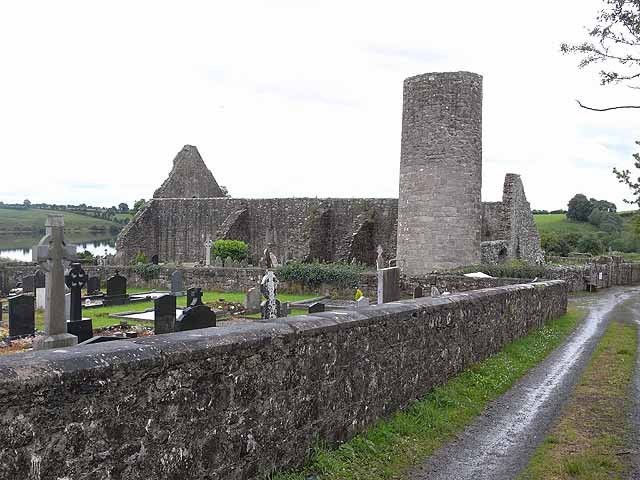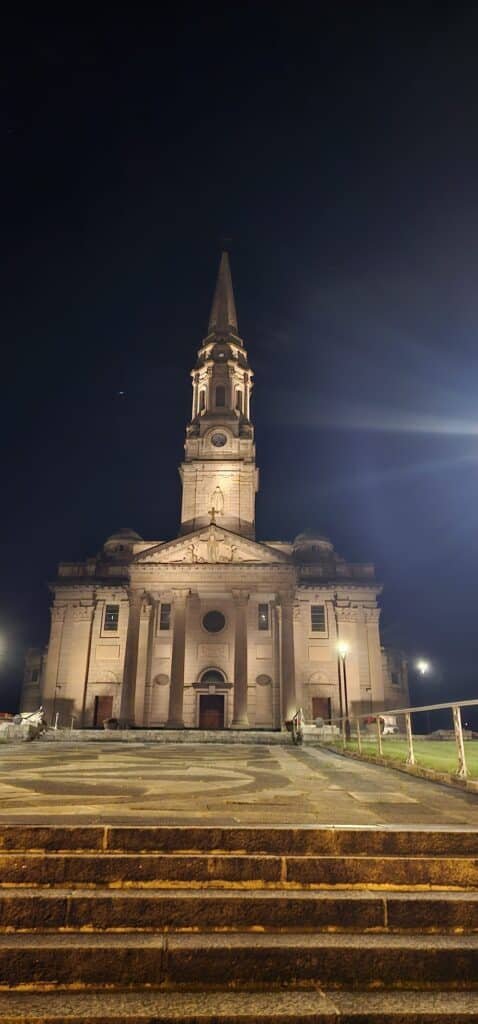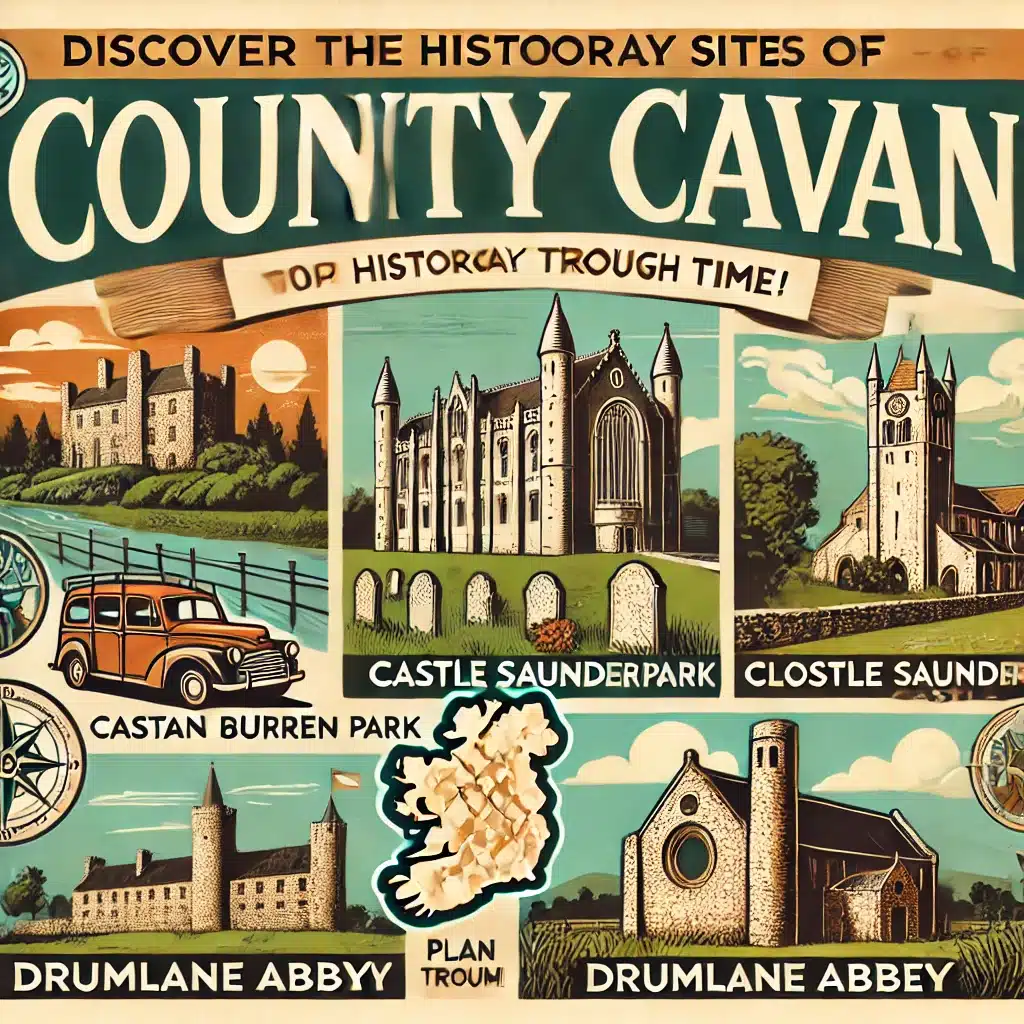Drumlane Abbey is a historical site located in County Cavan. It offers a glimpse into Ireland’s deep Christian heritage. Nestled near Milltown, the abbey stands as a testament to Ireland’s monastic past. Surrounded by scenic landscapes, Drumlane Abbey draws visitors interested in Ireland’s cultural history.
Drumlane Abbey’s origins date back to the 6th century. Its ruins, although weathered by time, evoke Ireland’s ancient spirituality. The abbey, believed to be founded by St. Mogue, is a vital part of Cavan’s history. Visiting it feels like stepping back in time when monasteries played key roles in Irish life. This article delves into Drumlane Abbey’s history, explores its architecture, and provides guidance for visitors.roles in Irish life. In this article, we’ll delve into the history of Drumlane Abbey, explore its architecture, and offer guidance on how to visit this historic site today.

Image by Oliver Dixon, licensed under Creative 2.0
Historical Background of Drumlane Abbey
Drumlane Abbey was founded by St. Mogue in the 6th century. Like many early Irish monasteries, Drumlane was more than a place of worship. It was a hub for education, art, and agricultural life. During its prime, it attracted monks, scholars, and locals from the surrounding regions. Drumlane’s location near the lough suggests water played an important role in the community’s life, both as a resource and symbol.
The monastery flourished for centuries, witnessing Ireland’s shift from paganism to Christianity. However, it faced challenges from the Norman invasion and later suppression under English rule in the 16th century. Despite these obstacles, Drumlane Abbey’s ruins remain as a reminder of Ireland’s medieval Christian roots.
St. Mogue: The Patron Saint
St. Mogue, also known as St. Aidan of Ferns, is a key figure in Irish ecclesiastical history. Born in County Cavan, he spread Christianity and established several monasteries. Drumlane Abbey is one of his primary contributions to Irish monastic life. St. Mogue’s influence has left a lasting mark on the abbey. His connection gives the site both historical and spiritual significance. Visitors often seek a deeper connection to Ireland’s Christian past at Drumlane Abbey, with St. Mogue at its heart.
Architectural Features of Abbey
Drumlane Abbey may lie in ruins, but several key features remain intact. These features provide insight into the architecture of the time. The most notable structure is the round tower, a common feature in Irish monasteries. The tower, dating from the 10th or 11th century, served multiple purposes. It functioned as both a bell tower and refuge during Viking raids. The Drumlane Round Tower is one of the best-preserved examples in Ireland. Its impressive height makes it visible from miles away.
The church, though roofless, showcases Romanesque features. The thick stone walls and narrow windows suggest it was designed for both worship and defense. The remains of the cloister, where monks prayed, provide further evidence of its religious role. Nearby, the abbey’s graveyard is still in use today. The gravestones range from modern markers to centuries-old stones. These stones contribute to a sense of continuity between past and present.
The Role of Monastic Life at
In its early years, Drumlane Abbey was a self-sustained community. Monks engaged in agriculture, copied manuscripts, and offered spiritual guidance. It was also a place of learning, where monks studied theology, philosophy, and science. Religious observances were central to daily life. Monks adhered to strict schedules of prayer, study, and work, following the rule of St. Benedict. The abbey’s remote location offered monks the peace needed for contemplation.

Image by DermotK, licensed Creative Commons 4.0
Viking Raids and the Abbey’s Decline
Like other Irish monasteries, Drumlane Abbey faced Viking raids during the 9th and 10th centuries. The abbey’s valuable manuscripts and treasures made it a target. Although Drumlane survived the raids, the constant threat of violence led to a decline in its prominence. The final blow came when Henry VIII dissolved the monasteries. Drumlane Abbey was abandoned, and its ruins stand today as a reminder of Ireland’s turbulent religious history.
Drumlane Round Tower Today: A Visitor’s Guide
How to Get There
Drumlane Abbey is located 3 kilometers from Milltown. It is accessible from Cavan and Belturbet. Visitors can drive to the site, with parking available nearby. The abbey is in a quiet, rural area, allowing peaceful exploration.
What to Expect
Drumlane Abbey is open to the public year-round, and admission is free. The round tower is a highlight of the visit. The surrounding graveyard and church ruins add to the site’s beauty. Take time to walk around the graveyard. You will see headstones that tell the stories of past generations. Wear comfortable shoes, as the terrain is uneven. The nearby Drumlane Lough also offers opportunities for quiet reflection.
Nearby Attractions in Cavan
While visiting Drumlane Abbey, explore other nearby historical sites. Belturbet is a charming town offering both natural beauty and historical attractions. You can also visit the scenic Crom Estate in County Fermanagh. Cavan Burren Park is another nearby destination worth exploring.
Preserving Drumlane Monastic Ruins: Ongoing Conservation Efforts
Efforts to preserve Drumlane Abbey have been ongoing for many years. The round tower has been the focus of conservation work to ensure its stability. Local historical societies and the Cavan County Council are committed to maintaining the site. By visiting Drumlane, you contribute to its preservation. Visitors are encouraged to respect the ruins and avoid damaging the structure or graveyard.
Conclusion
Drumlane Abbey remains a vital piece of Ireland’s historical landscape. Its connection to St. Mogue and its unique architectural features make it a must-visit. Whether drawn to the abbey for its religious significance or its beauty, a visit to Drumlane offers a profound journey into Irish history. Drumlane Abbey also links seamlessly with other attractions like Castle Saunderson and Cavan Burren Park. By visiting Drumlane, you keep alive the stories of the monks and contribute to the preservation of County Cavan’s rich history.
FAQs about Drumlane
Drumlane Abbey was founded in the 6th century by St. Mogue. It served as a monastic hub for education, worship, and community life until its decline in the 16th century. The abbey features a well-preserved round tower and a ruined church that reflect its architectural and religious significance.
Drumlane Abbey is located near Milltown, about 3 kilometers from the village. It’s easily accessible by car from nearby towns like Cavan and Belturbet. Ample parking is available near the abbey site.
No, visiting Drumlane Abbey is free of charge. The site is open to the public year-round, allowing visitors to explore its ruins and surrounding areas.
The round tower at Drumlane Abbey dates back to the 10th or 11th century. It served as a bell tower and refuge during Viking raids. The tower is one of the best-preserved examples in Ireland and remains a key feature of the site.
Yes, the graveyard at Drumlane Abbey is still in use today. Visitors can walk through the graveyard and see a variety of gravestones, ranging from modern markers to centuries-old stones.


